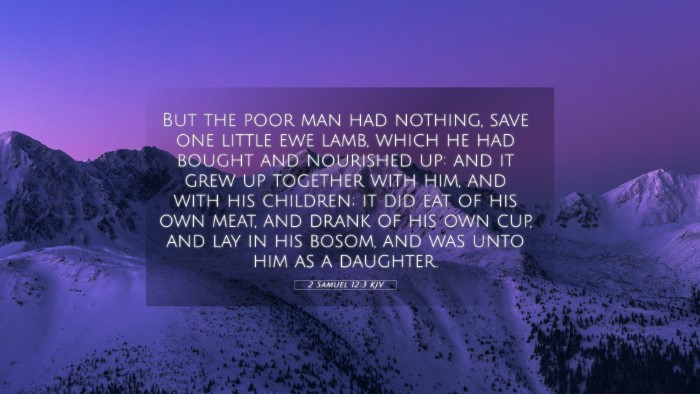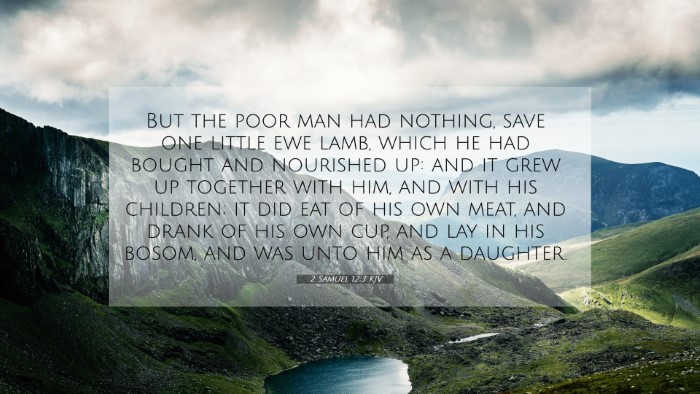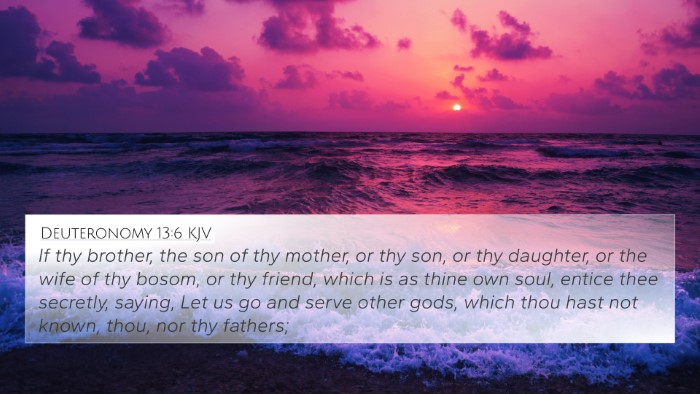Understanding 2 Samuel 12:3
Verse: "But the poor man had nothing, except one little ewe lamb that he had bought and nourished; and it grew up together with him and with his children. It ate of his own food and drank from his own cup, and lay in his bosom, and was like a daughter to him." (2 Samuel 12:3)
Summary of the Verse
This verse narrates a poignant story presented by the prophet Nathan to confront King David regarding his sin with Bathsheba. The poor man, with only one beloved lamb, symbolizes innocence and personal attachment, starkly contrasted with the cruelty displayed by the rich man who took the lamb from him. The imagery paints a vivid picture that evokes compassion and highlights the gravity of injustice.
Thematic Analysis
The central themes in this verse include:
- Injustice: The heart-wrenching reality faced by the poor man reflects the injustices often perpetrated by those in power.
- Personal Sacrifice: The love and care shown by the poor man towards the lamb emphasize the deep emotional connections we form with those we love.
- Divine Justice: Nathan’s parable illustrates God’s concern for justice and the accountability individuals have for their actions.
Commentary Insights
Matthew Henry: Henry emphasizes the depth of the poor man's love for the lamb, comparing it to a daughter, and how this leads to a heightened sense of betrayal when it is taken away. This parable serves as a crucial tool for bringing David to a place of recognition of his own sins.
Albert Barnes: Barnes notes that the story is a clever way for Nathan to reveal David's injustice without direct confrontation, allowing David to condemn himself through his own words. The emotional stakes elevate the seriousness of the crime against Uriah and Bathsheba.
Adam Clarke: Clarke indicates that the lamb represents Bathsheba and underscores the deeper implications of sin and its effects on the innocent. This allegory not only serves to chastise David but also illustrates the compassion of God in bringing about repentance through a relational narrative.
Bible Cross-References
This verse is connected with several biblical themes and verses:
- Lamentations 3:34-36: Speaking about God's concern for justice.
- Exodus 22:1: The law regarding stealing sheep, echoing the grave consequences of taking from the poor.
- Proverbs 22:22-23: God’s warning against oppressing the poor.
- Luke 16:19-31: The story of the rich man and Lazarus highlights similar themes of wealth and mercy.
- James 5:4: A reminder of the cries of the laborers who have been cheated of their rightful wages.
- Isaiah 10:1-2: A condemnation against unjust laws and leaders exploiting the vulnerable.
- Matthew 18:23-35: The parable of the unforgiving servant emphasizes mercy and justice.
Applications of Cross-Referencing
In studies involving Bible verse cross-references, these scriptures provide a richer understanding of 2 Samuel 12:3 within the broader narrative of justice and mercy found throughout the Bible. Cross-referencing Biblical texts allows for a comprehensive thematic exploration of how God's principles apply consistently.
Tools such as Bible concordances and Bible cross-reference guides can be invaluable in identifying these connections. Whether studying in a group or preparing a sermon, having access to a Bible reference resource can enhance one's understanding of how different parts of Scripture interact.
Conclusion
Ultimately, 2 Samuel 12:3 serves as both a narrative and a didactic tool. It underlines the importance of recognizing sin, invoking compassion, and the call for justice in a world marred by inequity. Implementing tools for Bible cross-referencing can enrich our interpretation and application of such profound passages.






